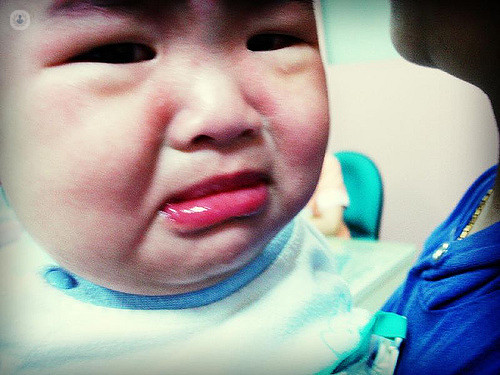


What is Kawasaki disease?
Kawasaki disease is a rare childhood condition mainly affecting children under the age of five. It causes inflammation in the walls of the blood vessels, which leads to a number of symptoms, including a rash, swelling, fever, and swelling and inflammation of the mouth and tongue (which is dubbed a “strawberry tongue” due to the red, swollen appearance).
Kawasaki disease affects around 8 in 100,000 children in the UK and is more prevalent in boys than girls.
Prognosis of Kawasaki disease
Most children recover within six to eight weeks if the Kawasaki disease is diagnosed and treated properly. The sooner the treatment begins, the quicker the recovery and the lower the chance of complications.
Complications can arise if Kawasaki disease affects the coronary arteries (the blood vessels supplying blood to the heart). Inflammation occurring here can cause an aneurysm, which can lead to blood clots, and in turn, heart disease or even heart attacks. Complications like these can be fatal, but this is rare. However, children who experience heart-related complications of Kawasaki disease may be left with permanent heart damage or left at a higher risk of developing heart conditions later in life.
Symptoms of Kawasaki disease
The first symptom of Kawasaki disease is usually a fever that does not respond to the usual remedies. Further typical symptoms include:
- Rash
- Dry or cracked lips
- Swollen glands in the neck
- Red eyes
- Redness and/or swelling in the fingers or toes
- Inflammation inside the mouth, including “strawberry tongue” – the tongue becomes very red and swollen and may have small lumps.
During the second phase of the disease, there may be skin peeling and a number of other symptoms, such as abdominal pain, vomiting, diarrhoea, fatigue, joint pain, and headache.
Symptoms begin to improve and disappear in the third stage, although the child may still get tired easily until fully recovered.
Medical tests to diagnose Kawasaki disease
A diagnosis of Kawasaki disease is usually based on the presence of at least four key symptoms (rash, swollen lymph nodes, changes (e.g. swelling) to the mouth or throat, changes to the hands or feet, and conjunctival infection in both eyes), coupled with a fever lasting longer than five days. There is no one test to diagnose the condition, but several tests may be performed to rule out other conditions like scarlet fever, measles, glandular fever, and lupus.
What are the causes of Kawasaki disease?
Kawasaki disease cannot be prevented. It is unclear exactly what causes it, but there are several theories:
- Infection, i.e. caused by bacteria or a virus – the symptoms are similar to other infections, yet it isn’t contagious, making a viral cause acting alone unlikely.
- Genetics – Kawasaki is more common in certain populations, e.g. Japan and Korea, which may mean certain genes are predisposed to the condition.
- Autoimmune – the body’s immune system mistakenly attacks healthy cells.
- Environmental – reaction to a pollutant, toxin, chemical, or medication.
- A combination of the above.
Treatments for Kawasaki disease
Kawasaki disease is usually treated in hospital due to the age of the patients and the severity of the possible complications.
Treatment involves two key components:
- Intravenous immunoglobulin – a solution of donated antibodies injected directly into a vein helps the body’s immune system.
- Aspirin – you should never give a child aspirin unless prescribed by a doctor. Kawasaki disease is one of the rare occasions when this might happen – aspirin helps reduce inflammation, swelling, fever, and pain, while also acting as an antiplatelet (it helps prevent blood clots).
Which type of specialist treats Kawasaki disease?
Paediatricians and paediatric cardiologists treat Kawasaki disease.
